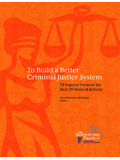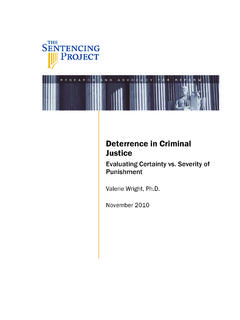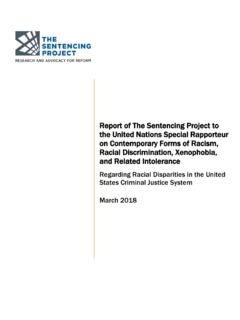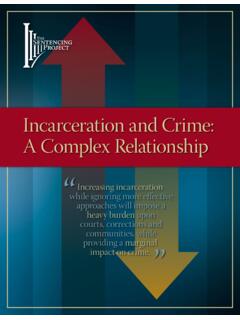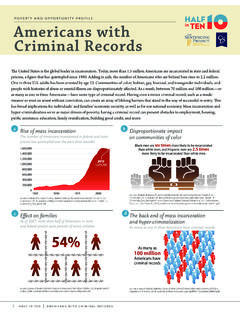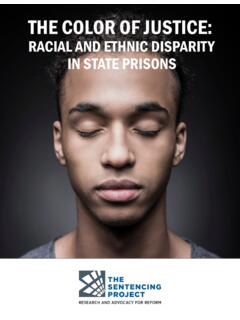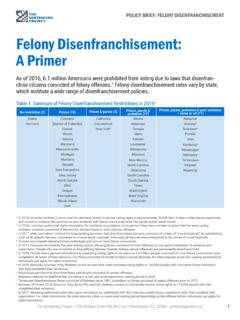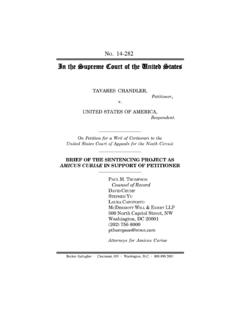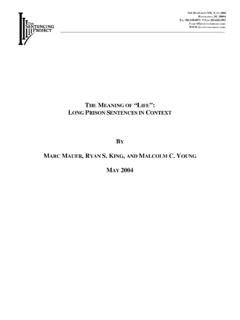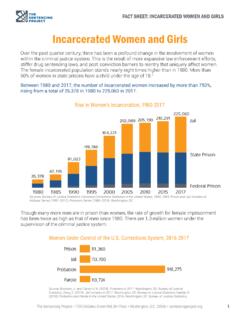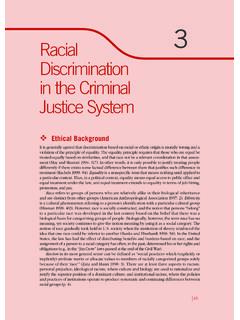Transcription of Deterrence in Criminal Justice - sentencingproject.org
1 Deterrence in Criminal Justice Evaluating Certainty vs. Severity of Punishment Valerie Wright, November 2010. For further information: This report was written by Valerie Wright, , Research Analyst at The Sentencing Project. The Sentencing Project The Sentencing Project is a national non-profit organization engaged 1705 DeSales St., NW in research and advocacy on Criminal Justice policy issues. 8th Floor Washington, 20036. (202) 628-0871. Copyright 2010 by The Sentencing Project. Reproduction of this document in full or part in print or electronic format only by permission of The Sentencing Project. Deterrence IN Criminal Justice |EVALUATING CERTAINTY VERSUS SEVERITY OF PUNISHMENT 1. O. ver the past several decades state and federal incarceration rates have increased dramatically. As a consequence of more punitive laws and harsher sentencing policies million people are incarcerated in the nation's prisons and jails, and the leads the world in its rate of incarceration.
2 Sentencing systems and incarceration traditionally have a variety of goals, which include incapacitation, punishment, Deterrence and rehabilitation. In recent decades, sentencing policy initiatives have often been enacted with the goal of enhancing the deterrent effect of the Criminal Justice system. Under the rubric of getting tough on crime, policies such as mandatory minimums, truth in sentencing, and three strikes and you're out have been designed to deter with the threat of imposing substantial terms of imprisonment for felony convictions. While the Criminal Justice system as a whole provides some deterrent effect, a key question for policy development regards whether enhanced sanctions or an enhanced possibility of being apprehended provide any additional deterrent benefits. Research to date generally indicates that increases in the certainty of punishment, as opposed to the severity of punishment, are more likely to produce deterrent benefits.
3 This briefing paper provides an overview of criminological research on these relative impacts as a guide to inform future policy consideration. Deterrence IN Criminal Justice |EVALUATING CERTAINTY VERSUS SEVERITY OF PUNISHMENT 2. CONCEPTUALIZING Deterrence . In broad terms punishment may be expected to affect Deterrence in one of two ways. First, by increasing the certainty of punishment, potential offenders may be deterred by the risk of apprehension. For example, if there is an increase in the number of state troopers patrolling highways on a holiday weekend, some drivers may reduce their speed in order to avoid receiving a ticket. Second, the severity of punishment may influence behavior if potential offenders weigh the consequences of their actions and conclude that the risks of punishment are too severe. This is part of the logic behind three strikes, and truth in sentencing policies, to utilize the threat of very severe sentences in order to deter some persons from engaging in Criminal behavior.
4 One problem with Deterrence theory is that it assumes that human beings are rational actors who consider the consequences of their behavior before deciding to commit a crime; however, this is often not the case. For example, half of all state prisoners were under the influence of drugs or alcohol at the time of their Therefore, it is unlikely that such persons are deterred by either the certainty or severity of punishment because of their temporarily impaired capacity to consider the pros and cons of their actions. Another means of understanding why Deterrence is more limited than often assumed can be seen by considering the dynamics of the Criminal Justice system. If there was 100% certainty of being apprehended for committing a crime, few people would do so. But since most crimes, including serious ones, do not result in an arrest and conviction, the overall deterrent effect of the certainty of punishment is substantially reduced. Clearly, enhancing the severity of punishment will have little impact on people who do not believe they will be apprehended for their actions.
5 1. Christopher Mumola. Substance Abuse and Treatment, State and Federal Prisoners, 1997. Bureau of Justice Statistics Special report , 1999. Deterrence IN Criminal Justice |EVALUATING CERTAINTY VERSUS SEVERITY OF PUNISHMENT 3. Economists often come to different conclusions than criminologists on the value of harsher sentences in reducing crime. While criminologists tend to regard various legal threats as the result of a complex and unpredictable process, economists approach the issue along the lines of a rational choice perspective that considers the risk and benefits of engaging in crime; sanctions merely represent the expected price of engaging in Criminal behavior. In critiquing this perspective, Michael Tonry, a leading scholar on crime and punishment, contends that Such research is incapable of taking into account whether and to what extent purported policy changes are implemented, whether and to what extent their adoption or implementation is perceived by would-be offenders, and whether and to what extent offenders are susceptible to influence by perceived changes in legal threats.
6 At the very least, macro-level research on deterrent effects should test the null hypothesis of no effect rather than the price theory assumption that offenders' behavior will change in response to changes in legal threats. 2. Another problem in assessing Deterrence is that in order for sanctions to deter, potential offenders must be aware of sanction risks and consequences before they commit an offense. In this regard, research illustrates that the general public tends to underestimate the severity of sanctions generally , 4 This is not surprising given that members of the public are often unaware of the specifics of sentencing policies. Potential offenders are also unlikely to be aware of modifications to sentencing policies, thus diminishing any deterrent effect. The absence of such data on awareness of punishment risks makes it difficult to draw conclusions regarding the deterrent effects of sanction levels and prospects. Below we explore these outcomes in greater detail.
7 2. Michael Tonry. Learning from the Limitations of Deterrence Research in Crime and Justice : A Review of Research edited by Michael Tonry. The University of Chicago Press, 2008. 3. Kirk R. Williams, Jack P. Gibbs, and Maynard L. Erickson, Public Knowledge of Statutory Penalties: The Extent and Basis of Accurate Perception, Pacific Sociological Review, 23(1), 1980. 4. Andrew von Hirsch, Anthony Bottoms, Elizabeth Burney, and P-O. Wikstrom, Criminal Deterrence and Sentence Severity: An Analysis of Recent Research, Oxford: Hart Publishing, 1999. Deterrence IN Criminal Justice |EVALUATING CERTAINTY VERSUS SEVERITY OF PUNISHMENT 4. CERTAINTY VS. SEVERITY OF PUNISHMENT. Criminological research over several decades and in various nations generally concludes that enhancing the certainty of punishment produces a stronger deterrent effect than increasing the severity of punishment. Key findings in this regard include the following: The Institute of Criminology at Cambridge University was commissioned by the British Home Office to conduct a review of research on major studies of Deterrence .
8 Their 1999 report concluded that the studies reviewed do not provide a basis for inferring that increasing the severity of sentences generally is capable of enhancing deterrent effects. 5 In addition, in reviewing macro- level studies that examine offense rates of a specific population, the researchers found than an increased likelihood (certainty) of apprehension and punishment was associated with declining crime Daniel Nagin and Greg Pogarsky, leading scholars on Deterrence , conclude that punishment certainty is far more consistently found to deter crime than punishment severity, and the extra-legal consequences of crime seem at least as great a deterrent as the legal consequences. 7. Similar findings are observed in micro-level studies on Deterrence that assess the likelihood of individuals engaging in crime. People who perceive that sanctions are more certain tend to be less likely to engage in Criminal activity. Scenario-based research using self-reports that examine the effect of certainty of punishment on individual behavior has shown that as the perceptions of the risk of arrest for petty 5.
9 Ibid. 6. Ibid. 7. Daniel Nagin and Greg Pogarsky. Integrating Celerity, Impulsivity, and Extralegal Sanction Threats into a Model of General Deterrence : Theory and Evidence, Criminology, 39(4), 2001. Deterrence IN Criminal Justice |EVALUATING CERTAINTY VERSUS SEVERITY OF PUNISHMENT 5. theft, drunk driving, and tax evasion increases, individuals report they would be less likely to offend. Researchers have also compared the relative importance of both certainty and severity as dimensions of punishment. In a 2001 study published in the journal Criminology, researchers utilized a sample of college students to assess the likelihood of drinking and driving. The authors found that the certainty of punishment was a more robust predictor of Deterrence than severity. Increasing the probability of apprehension by 10% was predicted to reduce the likelihood of drunk driving by , while the effect of severity eroded when the effects of certainty and severity were In another study, researchers compared crime and punishment trends in the , England, and Sweden, and failed to find an effect for severity.
10 9 The statistical associations were weak and even when there was a negative relationship between severity of punishment and crime rates, the findings were not strong enough to achieve statistical significance. This finding is noteworthy because it reflected varying degrees of punitiveness in the sentencing policies of the three nations. While most studies suggest that certainty of punishment is related to reductions in crime rates, some researchers speculate that increasing the likelihood of arrest and/or incarceration for both serious and minor offenses could cause sanctions, particularly imprisonment, to be viewed as less Nagin also emphasizes that sanctions have the potential to erode the deterrent effects of a policy because as he states, [f]or an event to be stigmatizing it must be relatively uncommon. 11. 8. Ibid. 9. David Farrington, Paul Langan, Per-Olof H. Wikstrom. Changes in Crime and Punishment in America, England and Sweden between the 1980s and the 1990s, Studies in Crime Prevention, 3:104-131, 1994.
